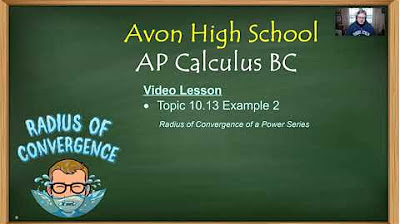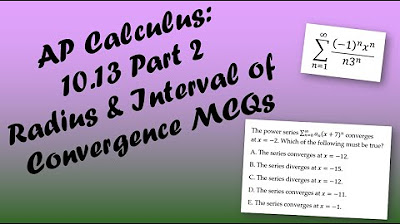Radius and Interval of Convergence
TLDRThis educational video script delves into the concepts of interval and radius of convergence for power series. It defines power series, explains the significance of the center, and outlines the three possible scenarios for convergence. The script guides viewers through the ratio test to determine the radius of convergence, illustrating the process with examples that include checking endpoints for convergence. The examples demonstrate how to find the interval of convergence and whether a series converges only at the center, within a radius, or for all real numbers.
Takeaways
- 📚 The lecture discusses the concepts of interval of convergence and radius of convergence in the context of power series.
- 🔍 A power series is an infinite series with powers of \( x - a \) or \( x - c \), where \( a \) or \( c \) is the center of the series.
- 🔢 The center of the series can be found by setting \( x - a \) or \( x - c \) to zero, which simplifies the series.
- 📈 The domain of a power series function is determined by the values of \( x \) for which the series converges to \( f(x) \).
- 🌐 There are three possibilities for the convergence of a power series: it converges only at \( c \), within a radius around \( c \), or for all real numbers.
- 🔍 The ratio test is used to determine the convergence of a series, checking if the ratio of the next term to the previous term is less than one.
- 📉 The endpoints of the interval of convergence must be checked to confirm whether the series converges at those specific values of \( x \).
- 🌀 The radius of convergence is found by analyzing the limit of the ratio of consecutive terms of the series as \( n \) approaches infinity.
- 🚫 If the limit of the ratio test is greater than one, the series diverges outside the center, indicating a radius of convergence of zero.
- ✅ An example is provided where the series converges for all real numbers, indicating an infinite radius of convergence.
Q & A
What is a power series in mathematics?
-A power series is an infinite series of the form \( \sum_{n=0}^{\infty} a_n (x - c)^n \) where \( a_n \) are constants, \( x \) is a variable, and \( c \) is the center of the series.
What is the significance of the center in a power series?
-The center in a power series is the value of \( x \) that makes \( (x - c) \) equal to zero, which is essentially the point around which the series is centered. It's the value that makes the series a constant.
What are the three possible scenarios for the convergence of a power series?
-The three possible scenarios are: the series only converges at the center (C), it converges within a certain radius around the center but diverges outside this radius, or it converges for all real numbers regardless of the value of \( x \).
What is the ratio test used for in the context of power series?
-The ratio test is used to determine the convergence of a power series. It involves taking the limit of the absolute value of the ratio of consecutive terms as \( n \) approaches infinity. If this limit is less than 1, the series converges; if greater than 1, it diverges.
How do you find the radius of convergence for a power series?
-The radius of convergence is found by applying the ratio test and solving the inequality that results from setting the limit of the ratio of consecutive terms less than 1. The radius is the value that satisfies this inequality.
What is the interval of convergence for a power series?
-The interval of convergence is the set of all \( x \) values for which the power series converges. It can be a single point (the center), an open interval, or all real numbers depending on the series.
Why is it necessary to check the endpoints of the interval of convergence?
-It is necessary to check the endpoints because the ratio test only applies to the interior of the interval. The behavior of the series at the endpoints may be different and needs to be evaluated separately to determine if the series converges at those points.
Can a power series converge for all real numbers?
-Yes, a power series can converge for all real numbers if the limit of the ratio of consecutive terms is less than 1 for all values of \( x \), indicating that the series is well-behaved and converges regardless of the value of \( x \).
What is the significance of the alternating series test in the context of checking endpoints?
-The alternating series test is used to determine if an alternating series converges. It is particularly useful when checking endpoints of a power series to see if the series converges at those specific values of \( x \).
What does it mean for a power series to have a radius of convergence of infinity?
-A radius of convergence of infinity means that the power series converges for any value of \( x \), indicating that the series is extremely well-behaved and has no restrictions on the values for which it converges.
What is the result of a ratio test limit going to infinity?
-If the limit of the ratio test goes to infinity, it indicates that the series diverges for all values of \( x \) except possibly at the center, resulting in a radius of convergence of zero.
Outlines
📚 Introduction to Power Series and Convergence
This paragraph introduces the concept of power series and the importance of determining their convergence. It explains that a power series is an infinite series of constants with powers of (x - a), where 'a' is the center of the series. The paragraph defines the power series centered at 'C' and discusses how to evaluate the series at different points to find the function it represents. The main goal is to find the domain of the function, which can be a single point, an interval, or all real numbers depending on the convergence of the series. The ratio test is introduced as a method to determine the convergence of the series.
🔍 Applying the Ratio Test for Convergence
The second paragraph delves into the application of the ratio test to find the radius and interval of convergence for a power series. It explains the process of taking the limit of the absolute value of the ratio of consecutive terms as 'n' approaches infinity. The example provided simplifies the ratio test to find the radius of convergence, which is determined to be 2. The interval of convergence is then found to be from 3 to 7, inclusive of 7 but not 3, after checking the endpoints. The explanation highlights the algebraic manipulation involved in the ratio test and the significance of the absolute value in determining the direction of convergence.
📉 Checking Endpoints and Examples of Convergence
This paragraph continues the discussion on convergence by emphasizing the need to check the endpoints of the interval of convergence. It provides an example where the endpoint x=3 results in a divergent series, similar to the harmonic series in reverse, while x=7 leads to a convergent alternating harmonic series. The explanation clarifies why the endpoint x=3 cannot be included in the interval of convergence. Additional examples are given to illustrate different scenarios, including a series with an infinite radius of convergence and another that only converges at the center. The paragraph concludes with a summary of the ratio test's utility in determining the convergence of power series.
Mindmap
Keywords
💡Interval of Convergence
💡Radius of Convergence
💡Power Series
💡Ratio Test
💡Convergence
💡Divergence
💡Center of the Series
💡Absolute Value
💡Harmonic Series
💡Alternating Series
Highlights
Introduction to interval and radius of convergence in power series.
Definition and explanation of power series with powers of X.
Introduction of the center of a power series and its significance.
Discussion on the convergence of a power series and possible domains.
Explanation of the three possibilities for power series convergence.
Introduction and application of the ratio test to determine convergence.
Detailed step-by-step process of applying the ratio test to a power series.
Simplification of algebraic expressions in the ratio test.
Identification of the radius of convergence using the ratio test.
Rewriting absolute value inequalities to find the interval of convergence.
Checking endpoints of the interval to determine if they are included.
Example of checking an endpoint (x=3) and determining it diverges.
Example of checking an endpoint (x=7) and determining it converges.
Conclusion of the interval of convergence and radius for the given series.
Another example demonstrating the application of the ratio test.
Explanation of how the limit approaching infinity affects convergence.
Identifying series with an infinite radius of convergence.
Final example showing a series that diverges for all values except the center.
Transcripts
Browse More Related Video
5.0 / 5 (0 votes)
Thanks for rating:





